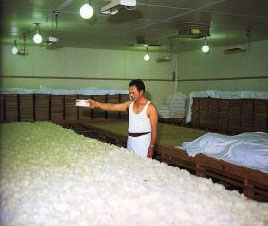Rice and sake

Rice takes an important part in Japanese life. For, its cultivation began over 2,000 years ago in Japan.Since that time, the cycle of rice production, from spring sowing to transplanting in paddies to harvesting in autumn, has been repeated year after year. Because the rice harvest is largely dependant on the weather, a number of ceremonies offering prayers to the Gods have developed over the years. Japan has a lot of festivals and many of them are closely connected to agriculture, such as the Rice Planting Festival (06/14 in Osaka), where twelve beauties ceremoniously transplant rice-seedlings in the shrine to the accompaniment of music and rice-planting folk songs, or the Harvest Thanksgiving Festival (10/23 in Japan). The earnest desire for a bumper crop reflects the fact that Japan has, through part of its history, not always been able to produce enough rice to feed its large population, although this is not a problem today. On the contrary, the Japanese government helps rice producers in order to maintain their exploitations against the ferocious southern Asian concurrence.
 Rice contains plenty of carbohydrates and proteins, and typically serves as a staple food eaten with dishes of fish and vegetables. It may be boiled and steamed to produce common white rice, or boiled with adzuki beans to make sekihan (red rice, often eaten to celebrate some event) or boiled with seasonal vegetables to make takikomi gohan (a rice dish that takes on the taste and colour of the vegetables it is boiled with). A glutinous type of rice is steamed and pounded to make mochi (rice cakes).
Rice contains plenty of carbohydrates and proteins, and typically serves as a staple food eaten with dishes of fish and vegetables. It may be boiled and steamed to produce common white rice, or boiled with adzuki beans to make sekihan (red rice, often eaten to celebrate some event) or boiled with seasonal vegetables to make takikomi gohan (a rice dish that takes on the taste and colour of the vegetables it is boiled with). A glutinous type of rice is steamed and pounded to make mochi (rice cakes).As well as being the staple food, rice is also the basic ingredient of sake and a variety of vinegar. The fact that Japanese sake has the highest alcohol content of any brewed liquor is due to a preparation issued from a long and difficult process we will describe below.
Sake is made from a polished rice which, compared to ordinary rice, is less glutinous, has larger grains, and has more white core nutrients. This polished rice is obtained by removing the outer layers. Generally, the percentage of white core nutrients remaining in the rice from which it is made, determines whether the sake will be good quality one. Smaller the core remaining is, better the sake is. For example, rice grains for eating have 91% of their core remaining (i.e. they are 9% polished). For ordinary sake, 60-70% of the rice remains after polishing, while for ginjo-shu sake, less than 60% remains. In the case of daiginjo-shu sake, one of the best, less than 50% remains.
